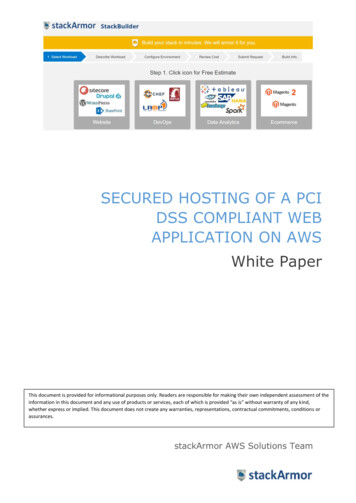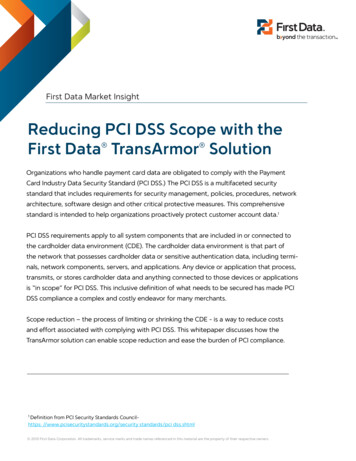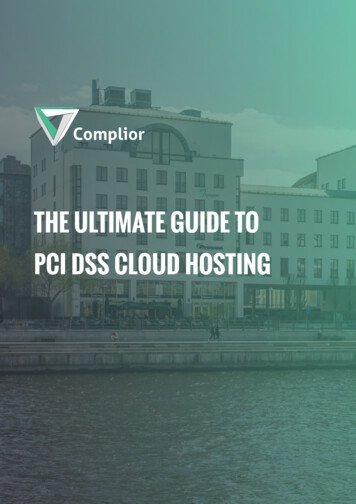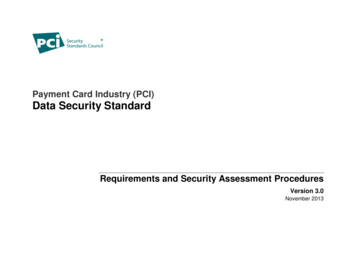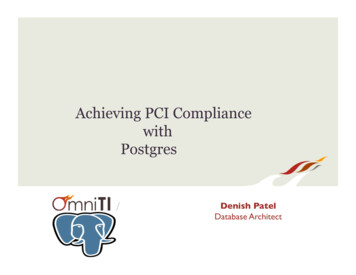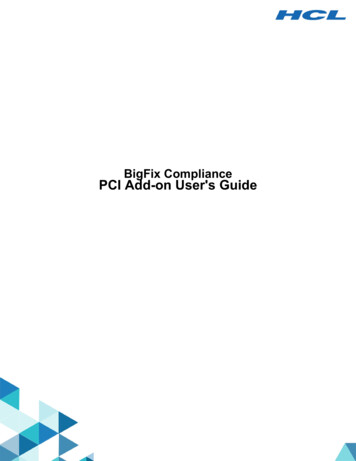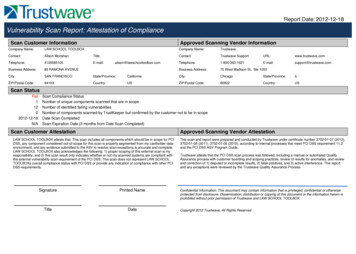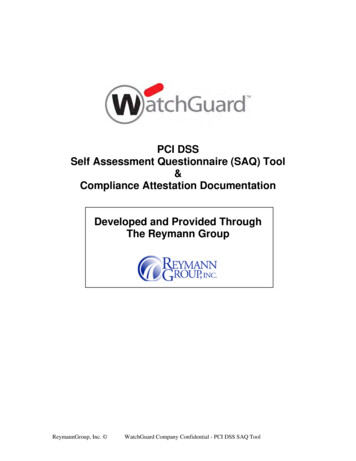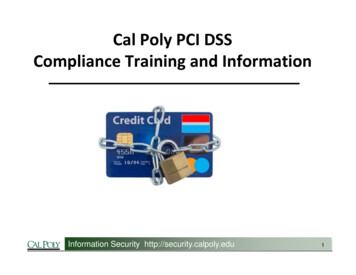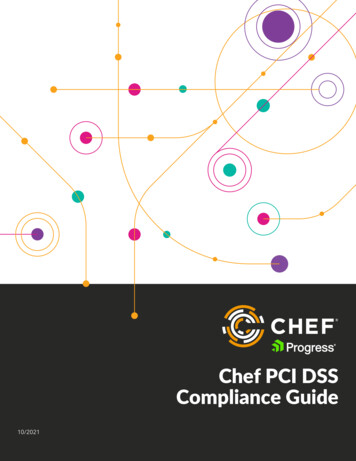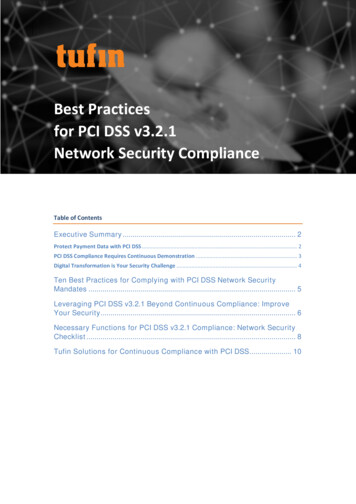
Transcription
Best Practicesfor PCI DSS v3.2.1Network Security ComplianceTable of ContentsExecutive Summary . 2Protect Payment Data with PCI DSS . 2PCI DSS Compliance Requires Continuous Demonstration . 3Digital Transformation is Your Security Challenge . 4Ten Best Practices for Complying with PCI DSS Network SecurityMandates . 5Leveraging PCI DSS v3.2.1 Beyond Continuous Compliance: ImproveYour Security. 6Necessary Functions for PCI DSS v3.2.1 Compliance: Network SecurityChecklist . 8Tufin Solutions for Continuous Compliance with PCI DSS. 10
Executive SummaryPayment data fraud by cybercriminals is a threat not only to financial institutions and retailorganizations, but to enterprises across every industry. And with the reliance on credit card paymentprocessing, the Payment Card Industry Data Security Standard (PCI DSS) is one of the most widereaching standards today. The goal of PCI DSS is to encourage and enhance payment data securityand facilitate the broad adoption of consistent data security measures globally. It protects againstfraud and security threats by providing a baseline of technical and operational requirements designedto protect payment data and the systems that contain or process it.To comply with PCI DSS, IT, security, and compliance teams must perform periodic audits orassessments. Furthermore, the PCI DSS Council updates the standard periodically to remediategrowing threats by cybercriminals. Therefore, complying with the latest PCI DSS standard andensuring that the enterprise network is audit-ready is a pressing concern of many IT managers andPCI DSS internal auditors today.Yet, according to Verizon’s 2018 Payment Security Report, “Lack of sustainable control environmentsremains a top contributor and precursor to ineffective controls, which in turn become susceptible todata breaches.” So, maintaining compliance and audit-readiness is certainly a challenge.This paper provides information to IT executives, security architects, compliance officers and internalauditors for understanding how PCI DSS version 3.2.1 requirements translate to network securitymandates and best practices through Network Security Policy Management (NSPM). Securitypractitioners and network operation teams will learn how to automate, design, plan, and integratecontrols required to comply with PCI DSS into everyday processes. NSPM solutions like TufinOrchestration Suite make network security management and audit preparation simple by providingpolicy-based automation across some of the most complex hybrid networks.Protect Payment Data with PCI DSSPCI DSS defines 12 high-level requirements, grouped into six control objectives. To assess compliance,compliance officers and internal auditors perform periodic audits in a frequency determined by thebusiness and the financial transaction volume they process. For example, audits can be performedmonthly, quarterly, semiannually, or annually. Audits assess compliance via numerous testingprocedures and sub-requirements to determine adherence to regulatory requirements, as seen in thetable below.PCI DSS Control ObjectivesRequirement DescriptionBuild and Maintain a SecureNetwork and Systems1. Install and maintain a firewall configuration to protect cardholder dataProtect Cardholder Data3. Protect stored cardholder data2. Do not use vendor-supplied defaults for system passwords and other securityparameters4. Encrypt transmission of cardholder data across open, public networksMaintain a VulnerabilityManagement Program5. Protect all systems against malware and regularly update anti-virus software orprograms6. Develop and maintain secure systems and applicationsBest Practices for PCI DSS v3.2.1 Network Security Compliance 2019 Tufin2/11
PCI DSS Control ObjectivesImplement Strong AccessControl MeasuresRequirement Description7. Restrict access to cardholder data by business need to know8. Identify and authenticate access to system components9. Restrict physical access to cardholder dataRegularly Monitor and TestNetworks10. Track and monitor all access to network resources and cardholder data11. Regularly test security systems and processesMaintain an InformationSecurity Policy12. Maintain a policy that addresses information security for all personnelThe main PCI DSS principle: Payment data is only as secure as the pathways that provide access to it.PCI DSS requirements are designed to ensure that your network security practices have a riskmanagement process. Beyond establishing a process, PCI DSS requirements ensure that yourorganization defines and documents well-structured policies, procedures, and practices that aretrackable and auditable. Automation of these practices and procedures saves you valuable time andeffort, streamlines the identification of risks and eliminates human error while ensuring fullauditability. To ensure data pathways are secure and adhere to strict network security policies, PCIDSS requires organizations to have: Specific guidelines to process card payments to prevent payment data fraud, skimming andother security threatsAlignment with industry best practices to increase the trust of both customers and partnersLimited external network access to sensitive data, combined with a formal process tomonitor all changes to your firewall configuration and cloud security groupsTrackable and auditable firewall and cloud operations, including clear definitions of roles andresponsibilitiesStrict limitations of internal access to your organization’s sensitive dataDocumentation, enforcement, and auditing of all your operational procedures and practicesIn summary, PCI DSS demands organizations maintain continuous compliance through an ongoingprocess of: Assess, Remediate and Report. To comply, your team must have an accurate picture ofyour compliance posture, the tools to address issues, and the ability to demonstrate compliancethrough internal and external audits.PCI DSS Compliance Requires Continuous DemonstrationPCI DSS compliance is required for businesses that store, process, or transmit payment cardholderdata, but demonstrating compliance only at a specific point in time is insufficient. PCI DSS compliancerequires a state of continuous compliance that involves much more than a periodic preparation andreview process. The most effective means to ensure compliance beyond periodic audits is to buildsecurity and privacy controls into your daily business activities. Your organization needs toincorporate risk identification, proactive change analysis, and mitigation into the operational levelswithin the organization, achieve visibility over their existing state of compliance and createenforceable guardrails to avoid introducing compliance violations.Best Practices for PCI DSS v3.2.1 Network Security Compliance 2019 Tufin3/11
Operational-level risk assessments trigger alerts generated by your operational-level systems andprocesses that can be used to escalate issues to management when events exceed pre-definedtolerances. Similarly, explicit risk-assessment discussions need to be included as part of businessplanning, execution, and evaluation meetings. Integrating risk analysis into your operational-levelactivities ensures compliance throughout change processes. Furthermore, continuous risk analysisand automated change tracking enables your organization to save considerable time and effort foraudit preparation.Digital Transformation is the Security ChallengeAbout 40% of PCI DSS is related to network security, but the growing complexity of hybridnetworks makes this compliance the largest headache. Fragmented ownership over the differentnetworking platforms, coupled with constant changes, necessitate operational adjustments toenforce security and compliance controls.Frequent changes to networking and security systems are necessary to support digital transformationand evolving business needs; for example, opening firewall ports to support connectivity of a newbusiness application. Your organization may make agility the top priority because it directly impactsrevenue. However, prioritizing business agility over security and compliance typically introduces risk,increasing susceptibility to attacks and the likelihood of costly audit failures.Your team requires a repeatable process, one that doesn’t interrupt business momentum, byingraining compliance during changes. This goal of repeatability and consistency is even moreimportant when considering the effort and time required when you manually document, track, andaudit network security changes, and resolve the inconsistent results. Your network security devices(e.g. firewalls, routers), SDN, and cloud platforms that often contain hundreds or thousands of rulesproduce an extremely complex enterprise network environment that can render securityunmanageable without consolidating policy and network management.To ensure compliance, your team must first have clear and centralized visibility over networktopology and security configurations across your network and cloud platforms. To demonstratecontinuous compliance, your security and network teams should use a zone-to-zone connectivitymatrix with a list of permissible or blocked services to assess the compliance of changes to avoiddelaying implementation. This compliance-based connectivity matrix serves as a technicallyreferenceable benchmark for PCI DSS compliance. Automated solutions for visibility, risk assessment,and enterprise network change management use this compliance benchmark to identify violations inthe network and ensure that new violations aren’t introduced inadvertently.In cases where rules violate compliance but are still justified as they enable connectivity of a criticalapplication, the violation should be designated as an exception. Designating a violation as anexception can be allowed to maintain a state of continuous compliance without impeding thebusiness. However, this process requires full documentation and the ability to assign an expirationdate to recertify or decommission the rule.Best Practices for PCI DSS v3.2.1 Network Security Compliance 2019 Tufin4/11
Ten Best Practices for Complying with PCI DSS Network SecurityMandatesPCI DSS serves as the de-facto standard for any company that stores, processes, or transmits paymentcardholder data. Because of the widespread applicability to businesses, IT, security, and compliancemanagers, regardless of industry, continually align their enterprise security program to adhere to thestringent standards of PCI DSS.Before getting into the PCI DSS requirement details, it’s best to understand how leading enterprisesenforce compliance with PCI DSS network security mandates. If your IT, security, and compliancemanagers execute compliance adherence effectively, their work on PCI DSS compliance serves as aspringboard into a tighter security posture, higher efficiency, and securely-enabled business agility.Ten best practices for complying with PCI DSS network security mandates:1) Create a clear separation with proper network segmentation of cardholder dataenvironment and cardholder data from the rest of the network. Even if you have a flatnetwork, it is important to segment it to logically isolate sensitive data. If you fail to do so,since all systems will have access to one another in a flat unsegmented network, your wholenetwork is subject to PCI DSS regulations.2) Identify and remediate policy violations in real time by designating alert mechanismsdifferently than other automated alerts. Security professionals are overwhelmed withautomatically generated alerts. However, PCI DSS violations need to be addressed as quicklyas possible to maintain continuous compliance.3) Establish consistent, auditable exception designation and management to ensure thatviolations that have been approved exceptions unto your network don’t prompt a failure ofyour PCI DSS audit. Reasons for exceptions need to be documented, as does the owner alongwith a date for expiration and a method for consistently reviewing exceptions prior toexpiration.4) Institutionalize an enterprise-wide network change workflow process that meets PCI DSSrequirements. Your company should automate change processes and execute them throughautomation to ensure consistency in steps and completion.5) Ensure every network change has a complete audit trail with the who, what, when, andwhy.a. The who is important to align to requirements for segregation of duties and forproviding documentation for auditorsb. The what is important for understanding modified policies, especially thoseconnecting to PCI-regulated network zonesc. The when is important to understand adherence to a change window, identifyemergency changes, or flag unscheduled and undocumented changes as anomalousbehavior for investigationd. The why aspect is critical for ensuring effective reporting for auditors, particularly inconsideration of retaining necessary violations as exceptions6) Validate every network change with the following:a. Risk analysis based on your security policy to determine whether access controlconfigurations violate PCI DSSb. Approval by the business owner to close the change request ticket as complete andclose the processBest Practices for PCI DSS v3.2.1 Network Security Compliance 2019 Tufin5/11
c.7)8)9)10)Implementation according to the PCI-compatible network change workflow toensure consistent adherence to PCI DSS process requirementsEnsure that access controls protecting cardholder data adhere to the following guidelines:a. Every rule has a comment that includes a date for regular recertification orexpirationb. Every rule has a logc. No rules with “Any” in the source, destination, and serviced. No rules with risky services (un-encrypted)e. Delete unused and redundant rulesf. Adopt a process for recertifying aging access rulesEnforce proper documentation of every access rule to ensure your audit preparedness withthe following information:a. Business justificationb. Business ownerc. Application named. Expiration or recertification dateMandate that firewall and cloud security groups logs are kept for at least 12 months forretrieval during your PCI DSS audit and align to data retention best practicesAutomate the rule cleanup and recertification processes to ensure all rules comply with PCIDSSLeveraging PCI DSS v3.2.1 Beyond Continuous Compliance: ImproveYour Security with AutomationPCI DSS v3.2.1 compliance is a business mandate that may also be used to get the buy-in andbudgets to ensure your network security is capable of ongoing success. To set high, sustainablesecurity standards, experts suggest you pay special attention to sub-requirements within PCI DSSrequirement 1.Taking a broader look at PCI DSS requirement 1 opens the door for implementing ongoing networksecurity solutions. This is significant if your organization has historically relied on manual processesthat won’t scale to meet the needs of the business and that diminish your network security posture.Enterprises with large networks need to automate access changes and security operations to enablebusiness agility. Investing in solutions for automating security processes reduces costs and efforts ofmaintaining continuous compliance with a variety of industry regulations and internal policies, andprovides ongoing benefits for the enterprise.The five PCI DSS requirements below require an ongoing process, not just a specific tool, to align withcompliance best practices, and can help you present the business case for automation to yourexecutive team.1.1.1 Verify that there is a formal process for testing and approval of all network connections andchanges to firewall and router configurations.Compliance managers need to ensure that a clearly defined, enforceable change process for accesspolicies exists. The PCI DSS external auditor will ask to see a change report with a full audit trail, andBest Practices for PCI DSS v3.2.1 Network Security Compliance 2019 Tufin6/11
then select some random changes and request to see the sign off.The Challenge: Many organizations still don't have a change process in place, and even if they do, theprocess is often too loose or reliant on manual implementation rather than a consistent, structuredflow.Security Best Practice: The best way to implement formal, auditable change processes is to automatea well-defined process flow. Having a solution that enforces and automates change processes ensuresconsistent approval and execution to align with the PCI DSS requirement of implementing anapproved formal process. As an example, organizations can automate the risk analysis of accesschanges, the approval chain of risk, and the integration with LDAP for identifying approvers.1.1.6 Documentation and business justification for use of all services, protocols, and ports allowed,including documentation of security features implemented for those protocols considered to beinsecure. Examples of risky services include FTP, Telnet, POP3, IMAP, and SNMP.This sub-requirement focuses on three main risks:1.2.3.Are connections required for business known? Are business justifications documented?Are access controls implemented with the Principle of Least Privilege?Are any of these connections insecure? Do compensating controls for them exist?The Challenge: Most organizations don't have an up-to-date list of allowable services that arepermissible for business. In the best case, documentation per access rule exists. Although it is mostlikely that some existing access rules contain insecure services.Best Practice: IT managers must document business reasons for each service used and ensure theinformation is retrievable and technically referenceable. Automation is the primary method toenforce consistent documentation of all rules and services. Beyond compliance, tracking thisinformation can be used to ensure continuity in documentation during personnel changes, or toidentify unused rules that are not justified and should be removed.1.1.7 Requirement to review rule sets for firewalls, routers and cloud security groups at least everysix monthsSecurity and network operations managers must prove that a review process exists and thatoutcomes are documented. To comply with this requirement you need a report to show that rule setswere reviewed, flagged rules from the last audit were treated appropriately, and that new rulesadded since the last audit were approved, documented, and designated as an exception if needed.Best Practice: Based on the 2018 Verizon Payment Security Report, change record validation is thelargest control gap for PCI DSS compliance. Many organizations find they cannot provide the requireddocumentation for the PCI DSS external auditor because manual processes make documentationimpossible. It is important to ensure well-defined processes for reviewing and recertifying accessrules are implemented, stringently followed, and documented. The best way to achieve all three is byautomating these processes. Automation will also improve SLAs, reduce costs and efforts of manuallyreviewing thousands of rules, and free the team to focus on more strategic security projects.1.2.1 Restrict inbound and outbound traffic to that which is necessary for the payment dataenvironmentPCI DSS external auditors often look for a set of rules that permit specific allowed services, such asapproved known protocols used by the PCI DSS servers, followed by an explicit drop rule for all otherBest Practices for PCI DSS v3.2.1 Network Security Compliance 2019 Tufin7/11
traffic. Exceptions must include proper documentation (such as rule comments and expiration) thatsatisfy the auditor.Best Practice: Setting explicit drop rules is easier than trying to correctly restrict inbound access.Proper definition of network zones protecting cardholder data makes compliance much simpler. It’stherefore important to ensure that your PCI DSS external auditor agrees to the zone definition andaccess control scheme. Secondly, your company must prove that you have a process to identify anddecommission redundant or unused access rules.An automated process for adding “necessary” access and for decommissioning redundant accessimproves consistency by eliminating human error and generates alerts whenever violations areintroduced. Beyond consistency and awareness, automation also allows proactively checking accesschanges for additional risks and misconfigurations.1.3.2 Limit inbound Internet traffic to IP addresses within the DMZIT and security managers must allow traffic from the Internet to specific servers in the DMZ —everything else should be dropped. Proper definition of traffic that is Internet (e.g. all non-local IPaddresses) and proper definition of the accessible systems within the DMZ are critical for compliance.Most important, your PCI DSS external auditor must agree that definitions are correct.Best Practice: Configure an active alert mechanism for non-compliant policies that allowunauthorized traffic so that IT managers can ensure network compliance. An automated workflow forprocessing access changes can proactively identify an attempt to allow unauthorized Internet trafficand address it even before it is implemented. Beyond documenting compliance, alerts can also flagmalicious behavior, such as compromised credentials, to alert your security team of an incident.1.3.4 Block unauthorized outbound traffic from the cardholder data environment to the InternetNetwork operation teams need to properly define the 'Internet' and 'cardholder data' environmentsby creating network segments that can be isolated. Your PCI DSS external auditor will validate thatthere is no direct access between these entities with supplied evidence.Best Practice: Utilize automation to manage and document access to integrate PCI DSS auditrequirements into the everyday IT and business activities. This ensures that your:1) Documentation is ready2) Alerts of violations have been generated and violations removed or designated as exceptions3) Access changes that allowed unauthorized outbound traffic were proactively flagged as riskyand mitigated prior to implementationNecessary Functions for PCI DSS v3.2.1 Compliance: Network SecurityChecklistSecurity and network operations teams can use the PCI DSS Network Security Checklist to preparefor audits. The checklist summarizes the key PCI DSS Requirements and Testing Procedures related tonetwork security. If best practices for network security are implemented in the organization, the PCIDSS audit is simply a healthy routine versus a compliance headache. Perhaps most important,compliance is continuous rather than occurring at a single point in time.Best Practices for PCI DSS v3.2.1 Network Security Compliance 2019 Tufin8/11
To meet the requirements related to network security in an efficient, quick, and manageable way,Tufin’s security policy management solution helps organizations to comply with PCI DSS version 3.2.1:PCI DSS Requirements & Testing ProceduresBuild and maintain asecure network andsystemsNecessary Tool Functions1.1 Establish and implement firewall and router configurationstandards that include the following: Inspect the firewall androuter configuration standards and other documentationspecified below and verify that standards are complete andimplemented as follows:1.1.1 A formal process for approving and testing all networkconnections and changes to the firewall and routerconfigurations1.1.2 Current network diagram that identifies all connectionsbetween the cardholder data environment and othernetworks, including any wireless networksNetwork segmentation, PCI DSSzone designation, networktopology modeling, and taggingfor cloud applications1.1.4 Requirements for a firewall at each Internet connectionand between any demilitarized zone (DMZ) and the internalnetwork zone1.1.6a Verify that firewall and router configuration standardsinclude a documented list of all services, protocols and ports,including business justification and approval for each.Network topology to identifyinternet access by all zones.1.1.7 Requirement to review firewall and router rule sets atleast every six monthsPCI DSS compliance reporting,risks and policy violationsreporting, rule recertificationautomation, task-basedmanagement for networksecurity adminsPCI DSS firewall and routerchecks, automated risk analysisagainst a central zone-to-zonebased connectivity matrix withPCI DSS risky services and ruleproperties, violations alerting andreporting, exception designationand trackingTopology mapping; centralizednetwork management to restricttraffic between Internet and PCIzone, alerts for violations1.2 Build firewall and router configurations that restrictconnections between untrusted networks and any systemcomponents in the cardholder data environment.(1.2.1a, 1.2.1b, 1.2.1c)1.3 Prohibit direct public access between the Internet and anysystem component in the cardholder data rationstandards for allsystem components.Assure that thesestandards address allknown securityvulnerabilities andare consistent withindustry-acceptedAutomation and documentationof all firewall and routerconfiguration changes, PCI DSSfirewall and router checks, PCIDSS requirements deviationdetection and reportingAutomatic risk analysis,automation and documentationof all firewall and routerconfiguration changes2.2.2 Enable only necessary services, protocols, daemons, etc.,as required for the function of the system.2.2.3 Implement additional security features for any requiredservices, protocols, or daemons that are considered to beinsecureA searchable zone-to-zone-basedconnectivity matrix with PCI DSSrisky services and rule propertiesto compare against firewall androuter configurations, networkwide policy search, exceptiontrackingAutomated risk analysis against acentral zone-to-zone-basedconnectivity matrix with PCI DSSrisky services and rule properties,rule documentation, networkwide policy search, and expirationdate tracking, and ruledecommissioningBest Practices for PCI DSS v3.2.1 Network Security Compliance 2019 Tufin9/11
PCI DSS Requirements & Testing ProceduresNecessary Tool Functionssystem hardeningstandards2.2.4 Configure system security parameters to prevent misuseTrack and monitor allaccess to networkresources andcardholder data10.1 Implement audit trails to link all access to systemcomponents to each individual user.Definition of required ruleproperties, rule decommissioningand rule expiration for removingunused/unnecessary accessFull accountability of policychanges with automated audittrail and reports; separation ofduties10.7 Retain audit trail history for at least one year, with aminimum of three months immediately available for analysis(e.g., online, archived, or restorable from backup).Retain a full audit trail of allchanges and traffic logs, for anyuser-configured time-range10.8 Additional requirement for service providers only:Implement a process for the timely detection and reporting offailures of critical security control systems, including but notlimited to failure of: Firewalls, IDS, FIM, anti-virus, physicalaccess controls, logical access controls, audit loggingmechanisms, segmentation controls (if used)Risks and violations reporting andalerts, network-wide policysearch, reporting, networktopology map for connectivitytroubleshootingAs most enterprises are adopting public and/or private cloud platforms, it is important to note thatalthough the PCI DSS standard relates predominantly to firewall environments, the TufinOrchestration Suite solution for Network Security Policy Management supports all leading networksecurity platforms, SDN and hybrid cloud platforms.Tufin Solutions for Continuous Compliance with PCI DSSTufin offers Network Security Policy Management solutions for physical networks and networkscomprised of SDN, cloud, and containers. Tufin’s policy management capabilities enrich policy dataacross your multi-vendor network to provide unified visibility over risky rules and violations, andBest Practices for PCI DSS v3.2.1 Network Security Compliance 2019 Tufin10/11
enable their decommission or exception designation and recertification through workflows. Tufinprovides PCI DSS templates to generate a technically referenceable zone-to-zone connectivity matrixwith the services and ports allowed or blocked between zones. The Unified Security Policy providesalerts on violations within your network for decommission, exception designation, and automatedrecertification with full audit tracking. Automated change tracking provides audit readiness whiledashboard and preconfigured reports provides visibility over your state of compliance.Organizations utilizing DevOps to achieve innovation and decrease time to market use Tufin cloudsolutions to gain visibility into cloud-native environments, define and control security policies, anduse automation to enhance the DevOps CI/CD pipeline to integrate security into the process.For more information on how you can achieve continuous compliance with PCI DSS using the TufinOrchestration Suite, please visit the Tufin website or learn how Monext uses Tufin for demonstratingPCI compliance.Best Practices for PCI DSS v3.2.1 Network Security Compliance 2019 Tufin11/11
1. Install and maintain a firewall configuration to protect cardholder data 2. Do not use vendor-supplied defaults for system passwords and other security parameters Protect Cardholder Data 3. Protect stored cardholder data 4. Encrypt transmission of cardholder data across open, public networks Maintain a Vulnerability Management Program 5.
